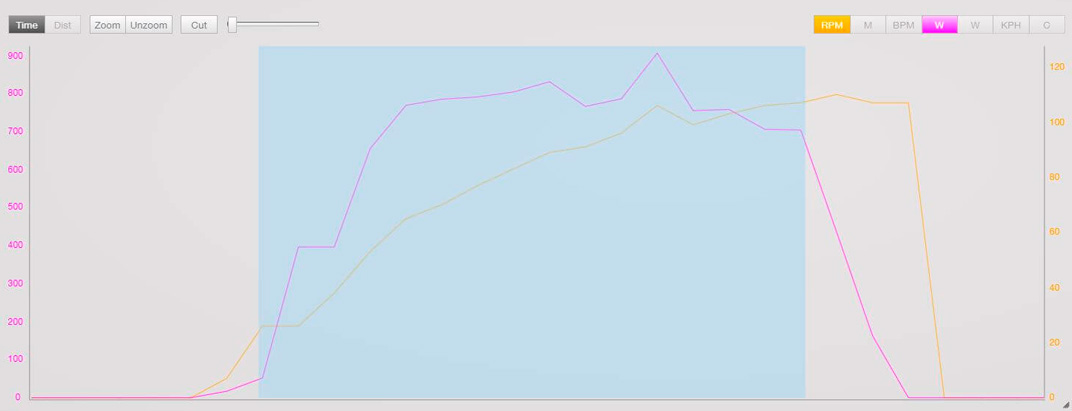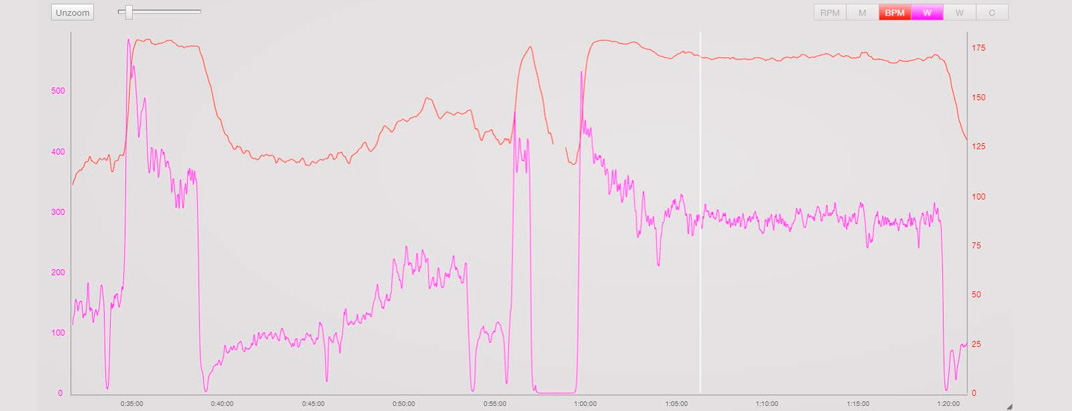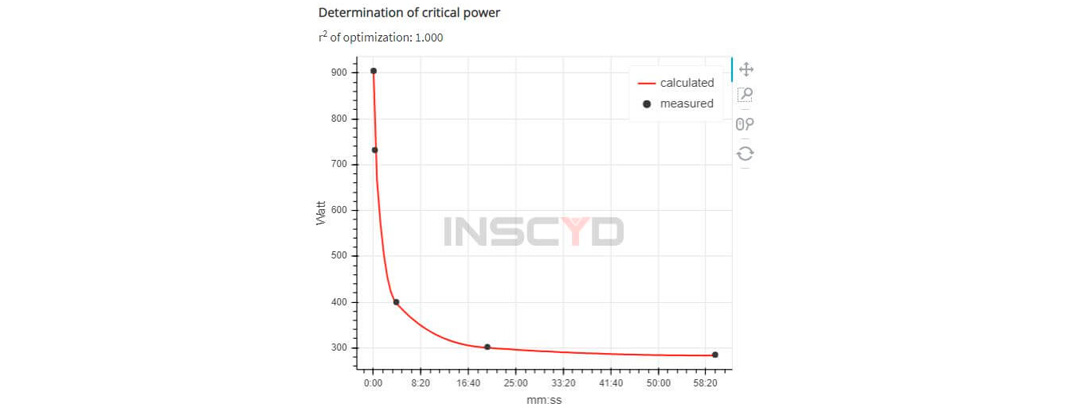How To Get An Inside View Into Your Physiology and Take The Guesswork Out of Training – Without Going To A Lab!
What is the best way to improve your power and performance on the bike?
Is it Sweet Spot training? High volumes of long slow distance? Perhaps polarised training?
The only correct answer is, it depends. But YOU will find out just what is the best solution for you, when you discover the building blocks of YOUR power, and how it is completely determined by two fundamental physiological variables.
No more guessing. Find out with confidence how you should be training to improve power and achieve your goals.
“ The benefits and use case of INSCYD of different user groups: athletes, scientists, coaches, physiologists, performance managers share their thoughts about INSCYD ”
How INSCYD metabolic profiling improves performance
Performance is not random. It can be broken down into a very small number of fundamental components. In cycling, we really don’t need to worry about much more than aerobic capacity (VO2max), glycolytic capacity (VLaMax), and aerodynamics.
We don’t even need to care about Functional Threshold Power (FTP, or the anaerobic threshold), as this is determined to 98% by the combination of VO2max and VLaMax.
If performance is so predictable, and we know how changing VO2max and VLaMax will impact your FTP and your race performance, then why is it that 99% of triathletes train without knowing WHY we do the training that we’re doing? It’s because we don’t understand our own physiology and metabolic profile.
With the INSCYD Critical Power testing service that you can do anywhere in the world, using only your power meter, you will learn get accurate information about your own physiology. And when you know what your VO2max, VLaMax, Anaerobic Threshold, Fat and Carb oxidation rates are, suddenly your training will no longer be a bunch of guesswork (you might call it educated guesswork, but it’s still guesswork).
Not only CAN you do this testing anywhere in the world, but you literally CANNOT do this testing in almost any laboratory. Typically these labs will only test your VO2max and your threshold, but you will not get to know your VLaMax. And since VLaMax is elite coaches’ secret weapon to performance, you should never do another lab test unless they too can provide you with this crucial metric.
Once you have completed the testing and received your results, you will KNOW for a fact which “knob to turn” – should you train your VO2max, your VLaMax, try to get your threshold to a higher percentage of VO2max, or should you practise your ability to oxidise fat?
We also have certain “training recipes” that you can use for each of the scenarios that you might encounter when you learn what your profile is.
Imagine the confidence it will give you knowing that you’re doing training that is RIGHT for you!
Metrics – a 360-degree view of your physiology
With an INSCYD critical power test you can obtain a full metabolic and performance profile. The test result is a multi-dimensional model that includes all the relevant physiological components of performance. Your capacity to perform in any race and the way you should train to improve on that performance can be boiled down into the following metrics that you will obtain.
From a 400m run to an IRONMAN triathlon, the aerobic capacity – or VO2max – is the single most important performance metric.Measuring VO2max isn’t something new. But with INSCYD testing you can now see how VO2max interacts with race and training performances:
- Explain changes in anaerobic threshold power.
- Compare the effect of high-intensity interval training over high-volume endurance training on VO2max and fitness improvements.
- Understand the impact of VO2max on fat oxidation and carbohydrate combustion.
- Evaluate the impact of specializednutrition regimes to further increase VO2max.
Along with your test results, you will get information and content on different ways to improve VO2max, so that if this is your limiter, you know what training you should do to address it.
There are two sides of VLamax (glycolytic capacity).
- On the one hand, a high VLamax increases the power available for short efforts: a 200m swimming race, a 400m run, an attack, a sprint.
- On the other hand, a low VLamax improves the anaerobic threshold and fat combustion and shortens recovery from hard efforts.
This means even for an Olympic distance race, you want a low VLaMax to maximise your performance. Knowing your VLaMax will be a game-changer in your training program:
- Explain changes in anaerobic threshold power, and plan for how to best improve threshold power.
- Plan your personal target VLaMax based on your goal races (there will be huge differences between an Ironman athlete and a cyclocross or criterium cyclist)
- Decide on what training will allow you to decrease/increase your VLaMax until you reach your own ideal VLaMax.
- Tune your nutrition to further help decrease/increase VLaMax.
- Understand the impact of VLaMax on fat oxidation and carbohydrate combustion.
Along with your test results, you will get information and content on different ways to alter (decrease or increase) VLaMax, so that whichever way you need to take it, you know what training you should do to do so.
INSCYD detects your anaerobic threshold as per the scientific definition: the maximum intensity at which lactate combustion matches lactate production. But knowing your threshold power simply isn’t good enough! Only if you understand WHY it is what it is can you effectively change it.
- High VO2max and high VLaMax? Reduce VLaMax.
- Low VO2max and low VLaMax? Increase VO2max.
- Anything in between? INSCYD will show you the relative strenght of your VO2max/VLaMax, and make it easy for you to decide which one to tackle first, in order to improve threshold power.
- Scientific validation of INSCYD’s threshold testing shows an accuracy of 2.5%. Better than with any other validated method.
- INSCYD offers the only detection of the anaerobic threshold which has been specifically validated in women – no other lactate or FTP test does this.
Along with your test results, you will get information and content on how best to tackle anaerobic threshold improvements in various scenarios, as described above.
Increasing fat oxidation and thereby sparing precious and limited glycogen is a very important part of endurance events. Especially so when we talk about half and full Ironman racing.
But fat and carb combustion is highly individual – there is no certain “percent of FTP” at which your maximum fat oxidation occurs, and how much carbs you use at e.g. your goal race intensity is natually also very much individual to you.
Use INSCYD’s accurate and validated fat and carb combustion reports to:
- Tailor your race (and training) nutrition plans to how much carbohydrate you actually combust at your race intensity.
- Use your own experience of your maximum tolerance for taking on energy in races to fine-tune your pacing plan so you don’t run out of fuel, and to set a benchmark for how much you should increase your tolerance to take on energy by practising it in training.
- Know your FatMax zone and train in it to improve your ability to oxidise fat for fuel.
- Use nutritional strategies to improve your fat oxidation and evaluate the impact of them.
Along with your test results, you will get information and content on different ways to use the knowledge of your fat and carb combustion rates to tailor race nutrition plans as well as to improve fat oxidation with training.
If your racing scene is high-level draft-legal triathlon or cycling disciplines with large variations in intensity (road racing, cyclocross, crit racing) then your ability to use lactate as fuel and to shuttle it is critical in your performance puzzle.
These abilities are highly trainable, and INSCYD testing allows you to monitor your progress and improvements in your production and combustion of lactate.
- Learn exactly how quickly lactate accumulates in your blood at any given intensity. This information will inform tactical racing decisions like when to initiate a breakaway, when to go with one, and when to hold back and keep it cool.
- Learn exactly how quickly you process and get rid of lactate at any given intensity. This information will inform tactical racing decisions like when should you nex try to do a breakaway after getting caught up from a previous attempt.
- Use knowledge of your lactate recovery rate to tailor your interval training recovery duration and intensity. You may want to do your recovery intervals at a higher intensity than you think, but also, make them longer than you think you should, to really optimise the effects of your training.
Along with your test results, you will get information and content on how to use knowledge of your individual lactate production and combustion rates to inform race tactics and to optimise interval training.
It’s about time we move on from thinking that everybody can be training various energy systems using the SAME generic percentages of FTP. The truth is, while you maybe should be doing VO2max intervals at 130% of FTP, your body might only do them at 110% of FTP, and 130% would kill him or worse, make him slower…
Your results will contain training zones completely individual to you and your physiology. Whether you want to go out and do VO2max intervals or a FatMax ride, you will have an accurate power target for you to hit your training objective.
- Recovery
- Endurance
- FatMax
- Moderate (“Medio”)
- Lactate Shuttling
- Anaerobic Threshold
- VO2max
- Anaerobic / Glycolytic
Along with your test results, you will get information and content on how to use your individual training zones to the best effect.
HOW IT WORKS
1. Critical power test – on the trainer or on the road, no laboratory needed!
After you order the test, you will receive all the information required about exactly how to perform the tests. Note that you can do the tests whenever you want, wherever you want. Most athletes do all the tests required within one single 90-120 minute ride.
You will be doing a 15-second sprint test, a 4-minute overpaced Time Trial (meaning you go out “too hard” and then hang on for dear life) and a 20-minute overpaced Time Trial. All separated by adequate recovery.
You send in the workout file, and leave the rest to us for analysing your files, selecting the right inputs, and then letting the software get to work and crunch the numbers.
2. Results – your physiology, your metabolic fingerprint, and your training zones
You will be sent a full report with all the metrics mentioned above, and a few key charts that will help you apply the information in practice. For example, as training interventions or race fuelling plans.
Importantly, you will also get training zones that apply to you as an individual. Let others train on fixed, generic percentages of FTP while you train according you your own physiology and metabolism. You’ll laugh all the way to the finish line!
You’ll also get access to plenty of content and information designed specifically so you can understand your test results and most importantly, apply it in practice in training and racing!
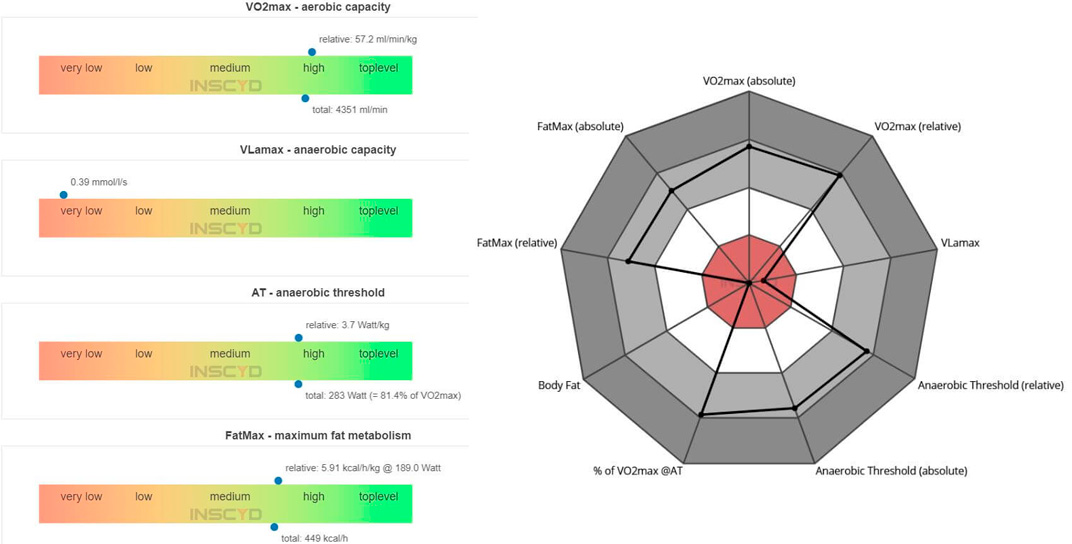

3. Train with no more guesswork – your results will tell you what you need to work on
Imagine two triathletes or cyclists, both weighing 75 kg. Both have a Functional Threshold Power (FTP) of 250W.
Rider A has a VO2max (Aerobic Capacity) of 50 ml/min/kg.
Rider B has a VO2max of 63!? How is this possible
Rider A has a VLaMax (Glycolytic Capacity) of 0.3 mmol/l/s.
Rider B has a VLaMax of 0.9.
A higher VLaMax means a lower FTP! And FTP is to 98% determined purely by VO2max and VLaMax.
For Rider A to improve their FTP, they need to improve their VO2max.
For Rider B to improve their FTP, they need to lower their VLaMax.
Two riders with the same FTP.
But two completely different training solutions to improve performance.
Unless you know your physiology and your metabolic profile in detail like this, any training that you do is like walking blind-folded in a dark room. You may find your way out or you may not.
To remove the blindfold and turn on the lights, it’s time to do some physiological performance testing and metabolic profiling. And you can do that without a lab – just you, you bike, your power meter, on the road or on your indoor trainer.
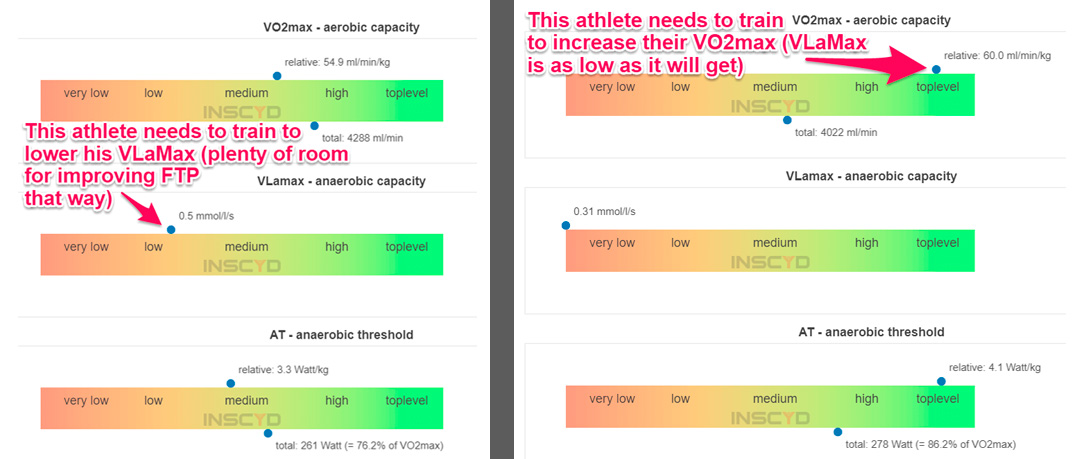
Are you looking for coaching?
Our team of expert coaches can help you give your best in triathlon competitions.
PRICE
INSCYD test
- Everything from starter
- Email follow-up:get any additional questions related to the test results



